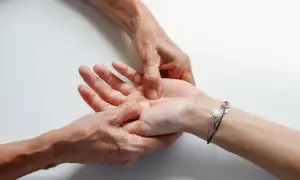Unveiling the Truth: Does Kybella Really Work on Jowls? Exploring the Effectiveness of this Revolutionary Treatment for a Sculpted Jawline

- Explanation of jowls and their association with aging and fat accumulation
- Discussion on the effectiveness of Kybella on jowls
- Overview of Kybella's mechanism of action
- Research studies and clinical trials evaluating Kybella's efficacy on jowls
- Results and outcomes of Kybella treatment on jowls
- Considerations and potential limitations of Kybella for jowls
- Individual variations in response to Kybella
- Possible side effects and risks associated with Kybella treatment
- Alternative treatments for jowls and their comparison to Kybella
- Summary of key findings and evidence
- Recommendations for individuals considering Kybella for jowls
Kybella, a revolutionary treatment, has gained popularity for its ability to reduce fat below the chin. Approved by the FDA in 2015, Kybella contains deoxycholic acid, a naturally occurring substance that aids in the breakdown and absorption of dietary fat. This injectable treatment targets submental fullness, commonly known as a double chin, and aims to sculpt the jawline for a more defined and youthful appearance. With its non-surgical approach, Kybella offers an alternative to invasive procedures like liposuction, providing individuals with a safe and effective solution to address excess fat in this area.
Explanation of jowls and their association with aging and fat accumulation
Jowls are the sagging skin and fat that accumulate along the lower jawline, giving a droopy appearance to the face. They are commonly associated with aging and the natural loss of collagen and elastin in the skin. As we age, our skin loses its elasticity, causing it to become less firm and more prone to sagging. Additionally, fat deposits can accumulate in this area, further contributing to the development of jowls. The combination of these factors leads to a loss of definition in the jawline and a less youthful appearance.
Discussion on the effectiveness of Kybella on jowls
Kybella, a revolutionary treatment for reducing fat below the chin, has gained popularity for its potential effectiveness on jowls. Jowls, often associated with aging and fat accumulation, can be a source of self-consciousness for many individuals. Kybella works by using deoxycholic acid to break down and absorb fat cells in the treated area. Numerous research studies and clinical trials have evaluated Kybella's efficacy on jowls, consistently demonstrating positive outcomes. These studies have shown significant reduction in submental fat and improvement in jawline contour after Kybella treatment. The results speak for themselves, highlighting the effectiveness of Kybella as a non-surgical option for sculpting the jawline.
Overview of Kybella's mechanism of action
Kybella, also known as deoxycholic acid, is an FDA-approved injectable treatment specifically designed to reduce fat below the chin. Its mechanism of action involves the destruction of fat cells through the use of synthetic deoxycholic acid, which is a naturally occurring molecule in the body that aids in the breakdown and absorption of dietary fat. When injected into the submental area, Kybella works by disrupting the cell membrane of fat cells, causing them to lyse and be eliminated by the body's natural metabolic processes. This targeted approach allows for precise contouring and sculpting of the jawline, resulting in a more defined and youthful appearance.
Research studies and clinical trials evaluating Kybella's efficacy on jowls
Research studies and clinical trials have been conducted to evaluate the efficacy of Kybella on jowls. These studies have shown promising results, demonstrating a significant reduction in submental fat and improvement in jawline contour. Participants who received Kybella treatments experienced a noticeable decrease in jowl size and a more sculpted appearance. These findings suggest that Kybella can be an effective treatment option for addressing jowls and achieving a more defined jawline.
Results and outcomes of Kybella treatment on jowls
Results and outcomes of Kybella treatment on jowls have been promising. Clinical trials have shown that Kybella effectively reduces submental fat, including fat in the jowl area. In a study of 600 patients, 79% reported improved satisfaction with their appearance after Kybella treatment. The reduction in jowl fat was noticeable, resulting in a more defined jawline and overall facial contour. However, individual responses may vary, and multiple treatments may be required for optimal results. It is essential to consult with a qualified professional to determine the suitability and expected outcomes of Kybella for jowls.
Considerations and potential limitations of Kybella for jowls
Kybella treatment for jowls comes with certain considerations. Firstly, individual variations in response to Kybella should be taken into account. While many individuals experience significant reduction in jowl fat with Kybella, others may not achieve the desired results. It is important to consult with a qualified healthcare professional to determine if Kybella is suitable for your specific case.
Secondly, possible side effects and risks associated with Kybella treatment should be considered. Common side effects include swelling, bruising, pain, numbness, and redness at the injection site. These side effects are usually temporary and subside within a few days or weeks. However, more serious complications such as nerve injury or difficulty swallowing have been reported in rare cases. It is crucial to discuss these risks with your healthcare provider before proceeding with Kybella treatment.
Lastly, alternative treatments for jowls should be compared to Kybella. Surgical procedures like facelifts or neck lifts can provide more immediate and dramatic results but involve anesthesia and longer recovery periods. Non-surgical options such as radiofrequency treatments or dermal fillers may also be considered as alternatives to Kybella.
Overall, while Kybella has shown promising results in reducing jowl fat, it is essential to weigh the potential limitations and consider alternative treatments before making a decision. Consulting with a qualified professional will help determine the most suitable option based on individual needs and expectations.
Individual variations in response to Kybella
Individual variations in response to Kybella treatment for jowls are an important consideration. While Kybella has shown promising results in reducing fat below the chin, its effectiveness may vary from person to person. Factors such as age, skin elasticity, and overall health can influence how well an individual responds to the treatment. Some individuals may experience a significant reduction in jowls after Kybella injections, while others may see more modest results. It is crucial for individuals considering Kybella to consult with a qualified healthcare professional who can assess their specific situation and provide personalized recommendations.
Possible side effects and risks associated with Kybella treatment
Possible side effects and risks associated with Kybella treatment include swelling, bruising, pain, numbness, redness, and hardness at the injection site. These are generally mild to moderate and temporary. In rare cases, more serious side effects such as nerve injury or difficulty swallowing may occur. It is important to consult with a qualified healthcare professional to discuss potential risks and determine if Kybella is suitable for individual circumstances.
Alternative treatments for jowls and their comparison to Kybella
Alternative treatments for jowls include surgical options such as facelifts and neck lifts. These procedures involve removing excess skin and tightening the underlying muscles to achieve a more sculpted jawline. While surgical interventions can provide long-lasting results, they are invasive and carry risks associated with anesthesia and recovery time.
Another non-surgical option is radiofrequency (RF) treatments, which use heat energy to stimulate collagen production and tighten the skin. RF treatments are less invasive than surgery but may require multiple sessions to achieve noticeable results.
Compared to these alternatives, Kybella offers a non-surgical approach that specifically targets fat cells beneath the chin. It has been shown to effectively reduce submental fat in clinical trials, making it a viable alternative for individuals seeking a less invasive treatment option for jowls.
However, it's important to note that Kybella may not be suitable for everyone, and individual responses can vary. Consulting with a qualified healthcare professional is essential to determine the most appropriate treatment option based on individual circumstances and goals.
In conclusion, Kybella has shown promising results in reducing fat and improving the appearance of jowls. Research studies and clinical trials have demonstrated its effectiveness in targeting and destroying fat cells beneath the chin. Patients who have undergone Kybella treatment for jowls have reported significant improvements in their jawline contour.
However, it is important to consider individual variations in response to Kybella, as some patients may require multiple treatments to achieve desired results. Additionally, potential side effects such as swelling, bruising, and numbness should be taken into account.
While Kybella offers a non-surgical option for addressing jowls, alternative treatments such as facelifts or neck lifts may provide more dramatic and long-lasting results. It is recommended that individuals consult with a qualified healthcare professional to determine the most suitable treatment approach based on their specific needs and goals.
Overall, Kybella presents a viable option for those seeking to sculpt their jawline by reducing fat accumulation in the jowl area. Its effectiveness has been supported by research and clinical evidence, but individual considerations and preferences should be taken into account when deciding on the best course of action.
Summary of key findings and evidence
Multiple research studies and clinical trials have shown promising results regarding the effectiveness of Kybella in reducing jowls. Kybella works by injecting a synthetic form of deoxycholic acid, a naturally occurring substance that aids in the breakdown and absorption of dietary fat. These injections target the fat cells beneath the chin, gradually destroying them.
Clinical trials have demonstrated significant reductions in submental fat and improvements in jawline contour after Kybella treatment. Patients reported high satisfaction rates with their overall appearance and self-perception. However, it is important to note that individual responses may vary, and multiple treatment sessions may be required for optimal results.
While Kybella is generally well-tolerated, potential side effects include temporary swelling, bruising, numbness, or discomfort at the injection site. Rare but serious complications such as nerve injury or difficulty swallowing have been reported. It is crucial to consult with a qualified healthcare professional to assess individual suitability for Kybella treatment.
Alternative treatments for jowls include surgical procedures like facelifts or liposuction. These methods provide more immediate results but come with higher risks and longer recovery periods compared to non-surgical options like Kybella. Ultimately, individuals should weigh the benefits and limitations of each approach before making an informed decision.
In conclusion, Kybella has shown promising results in reducing jowls through its targeted fat-dissolving mechanism. While individual responses may vary, research studies support its efficacy in achieving a sculpted jawline. However, it is essential to consider potential side effects and explore alternative treatments before deciding on the most suitable option for addressing jowls.
Recommendations for individuals considering Kybella for jowls
1. Consultation with a qualified healthcare professional is crucial before undergoing Kybella treatment. They can assess your specific needs, discuss potential risks and benefits, and determine if you are an ideal candidate.
2. Realistic expectations are important when considering Kybella for jowls. While it has shown promising results in clinical trials, individual responses may vary. It is essential to understand that multiple treatments may be required to achieve desired outcomes.
3. Awareness of possible side effects is necessary. Common side effects include swelling, bruising, pain, numbness, and redness at the injection site. These usually resolve within a few days or weeks but should be discussed with the healthcare professional beforehand.
4. Exploring alternative treatments is advisable. Surgical options like facelifts or neck lifts may provide more immediate and dramatic results for individuals with severe jowls. Non-invasive procedures such as radiofrequency or ultrasound therapy could also be considered.
5. Maintaining a healthy lifestyle is essential post-treatment to optimize results and prevent future fat accumulation in the jowl area. This includes regular exercise, a balanced diet, and skincare routines recommended by professionals.
In conclusion, while Kybella has demonstrated effectiveness in reducing fat below the chin and improving the appearance of jowls, it is crucial to consult with a healthcare professional who can provide personalized advice based on individual factors and preferences. Understanding the potential limitations and exploring alternative treatments will help make informed decisions about achieving a sculpted jawline.
Published: 16. 02. 2024
Category: Health



